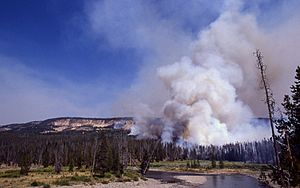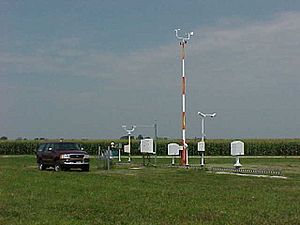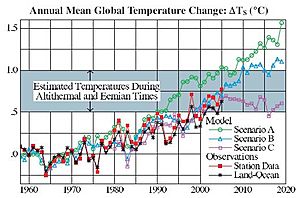James Hansen facts for kids
Quick facts for kids
James Hansen
|
|
|---|---|

Hansen in 2005
|
|
| Born |
James Edward Hansen
March 29, 1941 Denison, Iowa, U.S.
|
| Alma mater | University of Iowa |
| Known for |
|
| Awards |
BBVA Foundation Frontiers of Knowledge Award (2016) Tang Prize (2018) Heinz Award in the Environment (2001) |
| Scientific career | |
| Fields | Atmospheric physics |
| Institutions | Currently Columbia University; NASA Goddard Institute for Space Studies 1967–2013 |
| Thesis | The atmosphere of Venus : a dust insulation model (1967) |
| Doctoral advisor | Satoshi Matsushima |
James Edward Hansen (born March 29, 1941) is an American scientist who studies Earth's atmosphere and climate. He is a professor at Columbia University and used to lead the NASA Goddard Institute for Space Studies. He is well-known for his important research on climate change and for speaking out about the need to protect our planet. In 1988, he gave a famous speech to the U.S. Congress that helped many people understand global warming. He has also become an activist for climate action, sometimes being arrested during protests.
Hansen also suggested that the 0.7°C global temperature rise over the last 100 years could be mostly explained by greenhouse gases other than carbon dioxide, like methane.
| Top - 0-9 A B C D E F G H I J K L M N O P Q R S T U V W X Y Z |
Early Life and Education
James Hansen was born in Denison, Iowa. He studied physics and astronomy at the University of Iowa. He earned his bachelor's degree in 1963, his master's in 1965, and his Ph.D. in physics in 1967. During his studies, he also visited universities in Japan. In 1967, he started working at the Goddard Institute for Space Studies.
Career Highlights
After finishing his studies, Hansen continued to work on models that help understand how light and heat move through atmospheres. He first used these models to study the atmosphere of Venus. Later, he used them to understand Earth's atmosphere, especially how tiny particles (aerosols) and certain gases affect our climate. His work with global climate models has greatly improved our understanding of Earth's climate. In 2009, he wrote a book called Storms of My Grandchildren. He also gave a popular TED Talk in 2012 about why he felt he had to speak out about climate change.
From 1981 to 2013, Hansen was the director of the NASA Goddard Institute for Space Studies in New York City. This institute is part of the Goddard Space Flight Center.
Since 2014, Hansen has led a program at Columbia University that connects climate science with public awareness and policy actions. He has also supported young people in lawsuits against governments, arguing for a stable climate system for future generations.
Key Research and Findings
Studying Venus

In the late 1960s and early 1970s, Hansen studied the planet Venus. He tried to figure out why Venus's surface was so hot. He suggested that tiny particles in its atmosphere were trapping the planet's heat. Later studies showed that Venus likely had liquid water billions of years ago, but a "runaway greenhouse effect" caused the water to evaporate, creating a thick atmosphere of greenhouse gases.
Hansen also studied the clouds of Venus. He used how sunlight reflected off the planet to figure out that the clouds were made of sulfuric acid. This helped scientists understand Venus's atmosphere better.
Analyzing Global Temperatures
In 1981, Hansen and his team at NASA published their first study on global temperatures. They looked at temperature data from weather stations around the world from 1880 to 1985. They found that global average temperatures had warmed by about 0.5-0.7 °C over that century.
In 1988, they updated their analysis and found that the 1980s had some of the warmest years on record. On June 23, 1988, Hansen told the U.S. Senate that he was almost certain the Earth was warmer than ever before in recorded history. He said there was a clear link between this warming and the greenhouse effect. He also warned that extreme weather events would become more likely due to global warming.
After a large volcanic eruption in 1991 (Mount Pinatubo), global temperatures cooled slightly in 1992. However, by 1998, it was the warmest year since 1880. Hansen's team noted that the rate of temperature change was faster than ever before.
In 2001, Hansen's team made big updates to how they calculated global temperatures. They confirmed that global warming was continuing and that temperatures were about 0.8 °C warmer than a century ago. They concluded that this warming was real climate change, not just due to cities being hotter than rural areas.
Studies on Black Carbon

Hansen has also studied black carbon, which are tiny dark particles released from burning things like wood or fossil fuels. He and his colleagues found that black carbon can heat the air, leading to more rain in some areas and cooling the surface in others.
His research showed that many earlier studies underestimated how much black carbon was in the atmosphere. He also found that black carbon emissions increased rapidly after the Industrial Revolution but then leveled off. Recently, countries like China and India have increased their black carbon emissions due to fast development.
Human Impact on Climate
Hansen has focused on how human activities affect the climate. He has warned that human-caused forces on the climate are now stronger than natural ones. He believes that this can lead to big climate changes over time.
In 2003, he wrote that stopping global warming needs urgent international teamwork. He also said that a "dangerous" level of human impact on climate could be reached if the Greenland and Antarctic ice sheets become unstable. He warned that if greenhouse gases continue to grow, sea levels could rise by 10 meters, which would be a huge problem for coastal areas.
In 2007, Hansen's research suggested that warming of just 1 °C more would be very disruptive to humans. He concluded that carbon dioxide levels above 450 ppm are dangerous. He also noted that the Arctic climate has been affected by other gases as much as by carbon dioxide.
Climate Model Development
Hansen played a key role in developing global circulation models, which are computer programs that simulate Earth's climate. His first model, the GISS model, was published in 1974.
In 1981, Hansen and his team predicted that carbon dioxide in the atmosphere would cause warming sooner than many expected. They used a simpler model that showed similar results to more complex ones. He predicted that temperatures would clearly rise above natural variations by the 1990s.
In 1988, Hansen published the first climate prediction from a general circulation model. He estimated how much the average surface temperature would change based on different scenarios of future greenhouse gas emissions. He predicted that global warming would be clear within a few decades.
In 2006, Hansen and his team compared their 1988 predictions with actual observations. They found that the real-world greenhouse gas levels were closest to their "intermediate" scenario, and the observed warming matched their predictions well.
More recently, in 2023, Hansen and his team published a paper called "Global Warming in the Pipeline." They concluded that if carbon dioxide in the atmosphere doubles, the Earth's temperature could increase by 4.8 ±1.2 °C, which is higher than earlier estimates. They also suggested that less air pollution (aerosols) could speed up global warming, causing the world to pass the 1.5 °C warming limit before the end of the 2020s and 2 °C before 2050, unless big changes are made.
Climate Forcings and Sensitivity
In 2000, Hansen suggested a more hopeful way to deal with global warming. He focused on reducing non-carbon dioxide gases and black carbon in the short term. This would give more time to reduce fossil fuel emissions. He noted that the warming seen so far was about the same as what was expected from non-carbon dioxide gases alone. This is because carbon dioxide warming was partly balanced by cooling aerosols from fossil fuel burning.
In 2007, Hansen discussed the danger of "fast-feedback" effects that could cause ice sheets to break apart quickly. He pointed out that past climate data suggests ice doesn't melt slowly but can change suddenly. For example, 3.5 million years ago, when temperatures were 2-3 °C warmer than today, sea levels rose by 25 meters, not just a small amount. He warned that the "dangerous level" of human-made greenhouse gases is much lower than commonly thought.
In 2016, Hansen and other researchers published a paper about how meltwater from ice sheets could slow down ocean currents. This could speed up ice sheet melting and sea level rise by warming the water deep in the ocean.
Climate Change Activism
Speaking to the U.S. Senate
On June 23, 1988, James Hansen gave a very important speech to the United States Senate Committee on Energy and Natural Resources. He stated that "Global warming has reached a level such that we can ascribe with a high degree of confidence a cause and effect relationship between the greenhouse effect and observed warming...It is already happening now." He said NASA was 99% sure that the warming was caused by greenhouse gases building up in the atmosphere.
Many experts agree that Hansen's testimony greatly increased public awareness of climate change. It helped move the discussion from just scientists to a wider public and policy debate.
Criticism of the Coal Industry
Hansen has often criticized the coal industry, saying that burning coal releases the most human-caused carbon dioxide into the atmosphere. He has called for completely stopping the use of coal for power by 2030.
In 2007, during a testimony, Hansen used strong words to describe coal trains, comparing them to "death trains." He later apologized for causing pain to people who lost relatives in the Holocaust, saying he did not mean to trivialize their suffering.
Protesting Mountaintop Removal Mining
On June 23, 2009, Hansen and other protesters were arrested during a protest against mountaintop removal mining in West Virginia. This type of mining involves removing the tops of mountains to get to coal. Hansen said this mining "should be abolished." He was arrested again in September 2010 in front of the White House for protesting this mining method.
Against Cap and Trade
In 2009, Hansen spoke out against a system called "cap and trade" for reducing carbon emissions. Instead, he supported a "carbon tax" where fossil fuel companies would pay a fee for their carbon emissions. This money would then be given back to citizens equally. He has worked with groups like Citizens' Climate Lobby to promote this idea.
Retirement from NASA
Hansen retired from NASA in April 2013 after 46 years. He said he wanted to take a more active role in political and legal efforts to limit greenhouse gases.
Keystone Pipeline Protests
Hansen has strongly argued against the Keystone pipeline extension, which was planned to carry oil from Canada's oil sands to the Gulf of Mexico. He believes that oil from tar sands is a very "dirty" fuel because it releases a lot of carbon. He warned that the effects of climate change might not be fully seen for decades or centuries due to the climate system's slow response. He was arrested again at the White House in February 2013 during a protest against the pipeline.
Proposed Solutions
Hansen supports a system where a fee is placed on carbon emissions from fossil fuels, and that money is returned to the public. He believes this would make the true costs of fossil fuels clear.
In 2008, he suggested five priorities for solving climate and energy problems: efficient energy use, renewable energy, a smart grid, advanced nuclear power plants, and carbon capture and storage. He also supports using nuclear power to prevent deaths from air pollution and reduce greenhouse gas emissions.
Honors and Awards
James Hansen has received many awards for his important work. In 1996, he was elected to the United States National Academy of Sciences. In 2001, he received the Heinz Award for his global warming research. Time magazine named him one of the 100 Most Influential People in 2006.
In 2007, he shared the US$1-million Dan David Prize. In 2009, he received the Carl-Gustaf Rossby Research Medal, the highest honor from the American Meteorological Society, for his work on climate modeling and for clearly explaining climate science to the public.
In 2010, he won the Sophie Prize for his key role in helping us understand human-caused climate change. In 2016, he shared the BBVA Foundation Frontiers of Knowledge Award for creating the first computer models that could simulate climate behavior and correctly predict how much Earth's temperature would rise due to increasing carbon dioxide. In 2018, he was a joint winner of Taiwan's Tang Prize.
Images for kids
See also
 In Spanish: James Hansen para niños
In Spanish: James Hansen para niños












